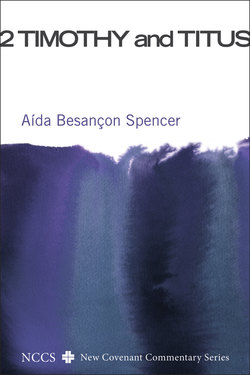Читать книгу 2 Timothy and Titus - Aída Besançon Spencer - Страница 7
На сайте Литреса книга снята с продажи.
Introduction to Pastoral Letters
ОглавлениеWhen Luke the evangelist wrote his Gospel, he highlighted for Theophilus, his reader, some of the features he offered, while affirming the Gospels already written (Luke 1:1–4). Following the model of this wonderful historian, I, too, would like to affirm the many wonderful commentaries written on the Pastoral Epistles, which are Pastor Paul’s instructions and admonitions to two young pastors. Like the other commentary writers of the New Covenant Commentary Series, I come from an international background, born and reared in Santo Domingo, Dominican Republic, and later in New Jersey in the United States, my mother from Puerto Rico and my father from The Netherlands. Like others in the series, I have focused on the flow of argument. My own translation is an attempt to illustrate the literal text as a basis for interpretation and stylistic analysis. I have studied the meaning of the text in light of its immediate and larger literary, biblical, historical, social, and cultural contexts. In particular, I have asked myself, how might these ancient communities have understood and received these teachings? To enrich my study, I traveled to Crete, Ephesus, Rome, and Greece, visiting many key ancient Greco-Roman sites. These were wonderful trips, which were accomplished with the help and companionship of my husband and son, Rev. Dr. William David Spencer and Mr. Stephen William Spencer.
In addition, I have always thought that scholarship would be advanced if more women were to study and publish on these letters that relate frequently to women and to church life. Thus, as a female Presbyterian minister ordained for over forty years (October 1973), I have paid consistent attention to any issues that relate to women and their role in the church. It is not, however, a commentary solely focused on “women’s issues.” As an active minister, who has taught New Testament theology for ministry for many years, I have also highlighted Paul’s ministry strategies, his coworkers, and their community. My own initial training was in stylistics, and, thus, when appropriate, I have also highlighted Paul’s rhetorical strategies.
Even though I have focused on the flow of argument, paragraphs and sentences are constructed from words and phrases. Therefore, in order to study the thoughts, I have also paid attention to semantics and grammar. I have done a close reading of the text. Like Luke, I have attempted to do a thorough investigation, but one understandable to my readers. My husband, as a theologian and a grammarian, graciously read the entire commentary. I am a “scholar,” but I am also a believer with the simple faith of a child (Luke 18:16–17). These words, although those of the Apostle Paul, are also God-breathed, I have, therefore, not read these letters as a skeptic, but as someone who is in love with God, who inspired the words and thoughts, and in sympathy with Paul, as a friend and colleague in ministry, who was mentoring other ministers in very difficult situations.
